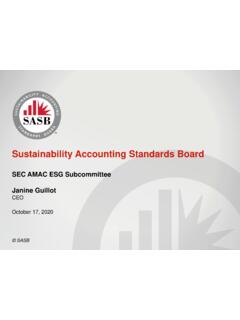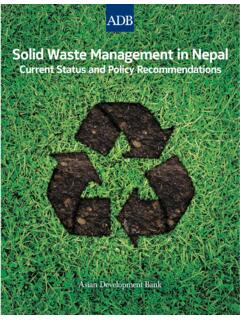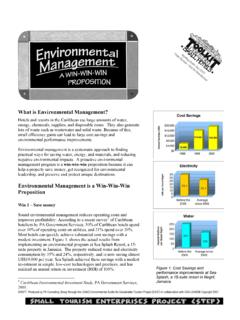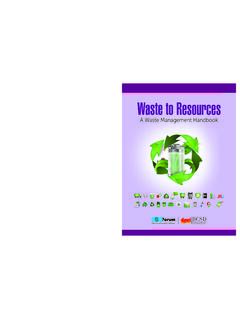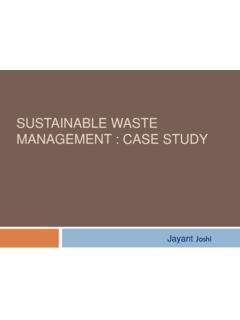Transcription of Global Material Resources Outlook to 2060 - OECD
1 Global Material Resources Outlook to 2060 Economic drivers and environmental consequencesHIGHLIGHTSG lobal Material Resources Outlook to 2060 Economic Drivers and Environmental Consequences Growth in materials use, coupled with the environmental consequences of Material extraction, processing and waste, is likely to increase the pressure on the resource bases of our economies and jeopardise future gains in well-being. This Outlook can help decision makers understand the direction in which we are heading and help to assess which policies can support a more circular economy. Angel Gurr a, OECD Secretary-General Global Material Resources Outlook to 2060 Economic Drivers and Environmental Consequences Key messagesThe economic In the coming decades, growing populations with higher incomes will drive a strong increase in Global demand for goods and services.
2 Global gross domestic product (GDP) is projected to quadruple between 2011 and 2060, according to the central baseline scenario projected with the OECD ENV-Linkages model. By 2060, Global average per capita income is projected to reach the current OECD level (around USD 40 000). Production and consumption are shifting towards emerging and developing economies, which on average have higher materials intensity. The growing share of services in the economy will reduce the growth in materials use as the sector is less materials intensive than agriculture or industry. Technological developments will help decouple growth in production levels from the Material inputs to production..of materials use Global materials use is projected to more than double from 79 Gt in 2011 to 167 Gt in 2060. Non-metallic minerals, such as sand, gravel and limestone, represent more than half of total materials use.
3 The materials intensity of the Global economy is projected to decline more rapidly than in recent decades at a rate of per year on average reflecting a relative decoupling: Global materials use increases, but not as fast as GDP. Recycling is projected to become more competitive compared to the extraction of primary materials. The strong increase in demand for materials implies that both primary and secondary materials use increase at roughly the same its environmental consequences More than half of all greenhouse gas (GHG) emissions are related to materials management activities. GHG emissions related to materials management will rise to approximately 50 Gt CO2-equivalents by 2060. Fossil fuel use and the production of iron & steel and construction materials lead to large energy-related emissions of greenhouse gases and air pollutants.
4 Metals extraction and use have a wide range of polluting consequences, including toxic effects on humans and ecosystems. The extraction and use of primary (raw) materials is much more polluting than secondary (recycled) facts and projections from the OECD Global Material Resources Outlook to 20604 . OECD HIGHLIGHTS Global Material Resources Outlook to 2060 Economic Drivers and Environmental ConsequencesOECD HIGHLIGHTS Global Material Resources Outlook to 2060 Economic Drivers and Environmental Consequences . 56 . OECD HIGHLIGHTS Global Material Resources Outlook to 2060 Economic Drivers and Environmental ConsequencesGlobal population growth is projected to slow down, but nonetheless, another 3 billion people are projected to be added to the 2011 total of 7 billion by 2060. At the same time, living standards are gradually converging across economies: per capita growth rates are higher in emerging and developing economies than in the OECD region (see Figure 1).
5 By 2060, the Global average gross domestic product (GDP) per capita is projected to reach the current level of the growth and income convergence together drive growth of the Global economy. The projected increase in population and tripling of Global per capita income levels combine to a quadrupling of Global GDP (see Figure 2). Large populations and rapid catching up of living standards in the People's Republic of China (hereafter China), and to a lesser extent in India and the rest of Southeast Asia, will drive Global growth the most. But Global growth is projected to be lower than in the past. The annual Global GDP growth rate is projected to stabilise below per year, a full percentage-point below the average at the turn of the century. A key driver of this is the decline in the growth rate of China, which is only partially offset by strong growth in other emerging economies such as India, followed by high growth in large parts of Sub-Saharan economic projections are also characterised by changes in the structure of the economy.
6 The main change is the shift of demand from manufacturing and agricultural goods towards services. At the Global level, the share of services is projected to increase from 50% to 54%. This is driven by income growth, digitalisation, and ageing. This servitisation trend holds for both industrial and final a Global Outlook to 2060 for future materials use at the sectoral and regional level for 61 different materials consists of three main steps:1. Projecting trends in the economic drivers of materials use. A comprehensive Global general equilibrium model is developed, representing the complex dynamics between economic activities across sectors and Linking materials use to the most relevant economic activity. Biomass Resources are linked to agricultural production activities; fossil fuels to fuel extraction sectors. Metals and non-metallic minerals are linked to the input of mining products into the processing sectors, including metals processing and construction.
7 3. Linking economic activities and materials use to environmental pressures. Emissions of greenhouse gases are linked to materials management and other economic activities. A wider range of life-cycle impacts are connected to extraction and processing of metals and construction materials. These projections are made with the OECD ENV-Linkages model under the assumption of no new policies, thus reflecting the implemented policy landscape of 2017. The baseline scenario describes one possible future development and is not a 1. A BASELINE SCENARIO APPROACHThe world has seen strong economic developments in recent decades. Global growth of GDP has been largely driven by fast-growing emerging economies like China and India. The coming decades are expected to bring further shifts in the geographical balance of the Global Global economy is on course to quadruple by 2060 OECD POLICY HIGHLIGHTS Improving Markets for Recycled Plastics Trends, Prospects and Policy Responses.
8 7 OECD HIGHLIGHTS Global Material Resources Outlook to 2060 Economic Drivers and Environmental Consequences . 7 EurasiaOther AmericaMiddle East & AfricaOther AsiaOECD PacificGDP at constant PPPOECD AmericaOECD EuropeWorld GDP rowth rate in % % % % % % Figure 1. Living standards are projected to gradually convergeFigure 2. Emerging economies drive the projected Global GDP growth HIGHLIGHTSO ther AfricaOther non-OECD AsiaOther Latin AmericaSouth AfricaBrazilIndiaNorth AfricaOther ASEANR ussiaCaspian re ionMexicoIndonesiaOther EuropeMiddle EastChileChinaOther EUOther OECD EurasiaOECD EU CanadaOECD EU JapanKoreaAustralia & New-ZealandUSAOECD avera ein OECD avera ein GDP per capita in GDP per capita in thousand USD in PPP 2 Socioeconomic and technological trends drive future materials useThe projections in the Global Material Resources Outlook to 2060 build on three key socioeconomic trends that affect materials use.
9 A detailed understanding of the evolution of the Global economy and how different economic activities link to the use of different materials is essential for an understanding of future materials convergenceStrong links between economic growth and especially convergence in income levels across countries and investment, infrastructure and construction drive a solid increase in Global materials use. As the economies of fast-growing countries mature and develop infrastructure, their use of non-metallic minerals and metals increases strongly. This has been occurring in China in the past two decades, and is projected to happen for many Asian and African countries in the coming decades, as shown in Figure 3. As China s construction boom gradually comes to an end, its demand for construction materials may stabilise below 25 Gt per year after changeThe demand for services by firms, government and households, which is projected to increase faster than the demand for agricultural or industrial goods leads to structural change in the economy.
10 As the services sectors have lower materials intensity (materials use per unit of output) than agriculture and industry, the Global materials intensity of the economy is likely to decrease by 2060. The high output growth rates and low materials intensity for the services sectors are shown in Figure 4. Motor vehicles and electronics have low total materials intensities, but are relatively large users of metals, and so drive the fast increase in metals improvementsTechnology improvements slow the growth in future materials use despite production growth. These reductions in materials intensity are projected to occur in all major sectors of the economy, albeit at widely varying rates, as shown in Figure 4. Together, income convergence, structural change and technology developments are projected to lead to a relative decoupling of primary materials use globally.










